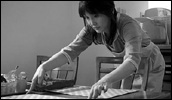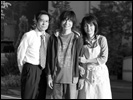Household X
- Year
- 2011
- Original title
- Kazoku X
- Japanese title
- 家族X
- Alternative title
- Family X
- Director
- Cast
- Running time
- 90 minutes
- Published
- 13 May 2011



by Roger Macy
The Berlinale is unquestionably an A-list film festival, so it's a definite feather in one's cap for a thirty-year old director to get his second film shown at the 'Forum' there in 2011. And in Koki Yoshida, the 'Forum' selected a filmmaker with a remarkably assured and independent voice.
Household X - or Family X, it could be translated - concerns one contemporary molecular family with three atoms spinning in very separate orbits. The opening shot is not exactly at the kitchen sink, but we stay very close to it for a long while as we get inside the world of a housewife, whose actions are obsessive, and cumulatively so. The acting, and especially the sound world are so convincing that we soon want to know how a sweet and normal person has got like this. But, apart from a smiling family photograph on the wall, from not so many years back, the viewpoint of the film is to never give us a back-story. Why would a move to a residential suburb have closed down all communication ? Are the son and husband frightened of her obsession, or has their taciturnity driven her here?
This family house becomes eerily well-known as we tread around it and learn its little echoes, but eventually we cut to observe husband and son at work. The husband turns out to be just as remote and uncommunicative in his workplace, but the son, played by Tomohiro Kaku, struggling to make a way in the world in short-time work, proves to have the will to communicate and grasp small opportunities. So his youthful grunting at home may be normal, but this film is willing to look at the consequences of normality.
'Tadaima' as a home-entering expression may not be quite as de rigeur in Japan as it was in the age of classical Japanese cinema, but it's still so widely used that the absence of this, or any other expression, indicates something wanting. It's well over an hour in this ninety-minute film, before either male says 'tadaima' when slinking back to household X. Even more remarkable is that it takes longer for us to learn our housewife's name (Michiko) - inevitably when she is finally absent herself.
Kitchen sinks, obsession, and taciturnity do not usually make an attractive film but Household X kept my close attention without any sense of being hard to watch. This has everything to do with the quality of the filmmaking. Yoshida has elicited highly convincing acting, especially from Kaho Minami, who plays Michiko (housewife X). When we eventually follow Michiko in the streets around her suburban home, the camerawork has given us the viewpoint of an exterior explored from household X. A long tracking scene is superb, and again, it is attention to the sound world that distinguishes it. The film has a forward momentum that belies its avoidance of obvious causal links or musical bridging (the credit for music must, I think, relate only to the closing credit sequence). Development is often strongly visual, such as when Hiroaki, the son, takes a photo for customers he just helped move, subtly quoting the picture that hangs on the wall at home.
I got the opportunity to ask Yoshida-san a few questions in Berlin. We had some language difficulties, bridged on both sides by intermediaries, but it was still helpful for me. I was interested to learn just how strongly the film was scripted - or were the actors free to extemporize? It seems that it was both. The script itself took a year and had fifteen major revisions. But Yoshida's approach, even though his budget gave him little rehearsal time, was to encourage the actors to start from their own experience and build from that. It was apparently in this way that Yoshida's viewpoint, initially of the son's, oriented towards that of the mother, Michiko. This would suggest that the closing of the camera and microphone upon Michiko, which so emphasises the housewife's obsession in the first reels of this film, was a late input. In contrast, we never follow the footsteps of Kenichi, the husband - played by Tomorowo Taguchi - until he starts to look for Michiko. I use 'reels' advisedly, as the film's whole appearance is one of physical film-stock. Funding came from a Pia Film Festival scholarship.
For the thinking behind the making of this film, and for its predecessor, the self-produced Symptom X, I was surprised how much Yoshida was willing to acknowledge his personal history. But, in a sense, I would rather draw a veil over that, as it would give the wrong impression. This is certainly not a film that presents itself with any baggage of analysis. Yoshida's willingness to let his actors have their heads is more a symptom of confidence in his technique and vision. It may help that he hasn't come from nowhere - he has been described as Nobuhiro Suwa's 'favorite disciple' and his experience as assistant director on Shinya Tsukamoto's Nightmare Detective series has evidently given him the background skills and contacts to assemble a formidable team for his commercial debut.